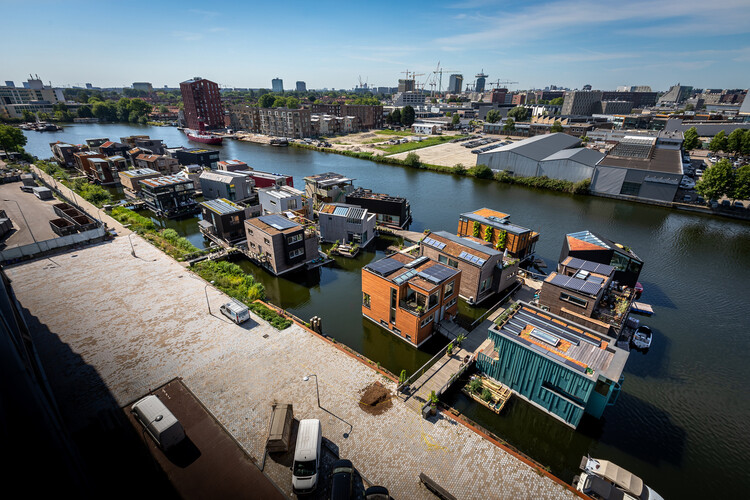
While circular economy is often discussed in relation to the architectural object through the lens of material recycling, design for disassembly, and material passports, the framework is most fully enacted at the neighbourhood and city scale. Whether it is visions of circular communities that hint at some level of self-sufficiency or policies set in motion by cities, urban-scale projects exemplify the guiding principles of the circular economy, providing a glimpse into what a fully-fledged version of it might look like. The following explores the strategies used in circular urban environments, from architecture and construction materials to energy production, waste management and food production, as well as the processes and operations that govern these designs, providing insights into the conditions that inform circularity.
The circular economy is usually reduced to the 3Rs -Reduce-Reuse-Recycle, the concept is much more complex, presenting multiple ramifications that involve paradigm shifts in how urban environments are designed. Cities are resource consumption centres and significant producers of greenhouse gas emissions. The prevailing economic model is linear and translates into raw materials being mined to manufacture components that are subsequently used and ultimately end as waste at the end of their lifecycle. The demand for raw materials is predicted to double by 2050. Urban communities are central to developing circular economy models. It is essential to analyze the urban structure as a whole.
In 2020, the EU published a Circular Economy Action Plan, one of the critical components for implementing the Green New Deal. The strategy involves designing sustainable products, reducing waste and creating an EU market for secondary materials, among other steps. The plan outlines the possible introduction of recycled content requirements for certain construction products, a significant paradigm shift for building codes for the construction sector. Additionally EU seeks to promote initiatives to reduce soil sealing and rehabilitate abandoned or contaminated brownfields.

Cities are already spearheading efforts to combat climate change and setting the groundwork for a circular economy, further enabling various climate mitigation opportunities. Developing circular economy strategies requires creating a holistic understanding of how a city manages its resources what are its waste patterns and engaging private stakeholders in becoming partners in a new local economic framework.
A trailblazer in establishing a local circular economy is the city of Prague. In 2019, the city, together with Amsterdam-based organization Circle Economy, analyzed local material flows and carbon emissions in relation to the local economy to identify the key industries where circular economy practices could be introduced. The resulting action plan translated into creating a network of Re-Use points that process discarded elements such as appliances and furniture, collecting household food waste that is converted into biogas and implementation of circular agricultural principles on the farming land around the city.

Besides the policies regulating resources, products and waste management, at the urban planning level, there is a strong focus on self-sufficiency in terms of energy and food production, as well as an increased preoccupation with community involvement. Amsterdam-based practice Space&Matter has successfully implemented circular economy principles at the neighbourhood level, capitalizing on participatory processes. In its pursuit of future-proof urban environments, the architecture firm established a project development firm that would enable a co-creation process involving citizens and end-users. For the practice, getting people involved in the design and governing of their communities is one of the key steps in developing a circular economy.

One of the firm's most notable projects is Schoonschip, an innovative circular neighbourhood in Amsterdam and a community-driven project. Home to more than 100 residents, the project features decentralized and sustainable energy, water and waste systems. A smart grid of solar panels helps residents trade energy among themselves while water treatment technologies retrieve energy and nutrients from wastewater. The owners association wanted to share the information accumulated during the development of the project; therefore, the project is open source. The knowledge that went into creating the residential development has been compiled on a website detailing various aspects, from materials to food production to legal aspects.

For the Taisugar Circular Village in Taiwan, design studio Bio-architecture Formosana focused on modularity to streamline assembly and disassembly and simplify the material bank database. The project features renewable energy systems, shared amenities and a series of food production systems, including aquaponic. sAt the same time, the project implements the product-as-service model, with the elevator, lighting, furniture, and sanitary fixtures rented instead of purchased. Turning towards rural landscapes, Valentino Gareri Architects has designed the pilot project for a circular economy village model. In a garden-city-like fashion, the concept envisions communities of up to 200 people featuring co-working and co-living spaces with water and energy micro-grids and a regenerative agricultural system. The project will also convert inorganic materials into new products or other resources, similar to Prague's re-use points.

Moving towards a fully circular economy is a multi-step, complex process that is mostly policy-driven. However, as illustrated by these few examples, architects, urban designers and communities can take the initiative of translating the circular framework at the scale of an urban development, through interventions that not only contribute to forging the circular economy vision but advance knowledge in the field.
This article is part of the ArchDaily Topics: The Road to Net Zero Architecture presented by Randers Tegl.
Randers Tegl aims to take responsibility and think sustainable as a part of reaching the goal of Net Zero. Both in terms of how building materials impact the climate and how the materials age, but also with a focus on architecture. That is why Randers Tegl created their sustainable series GREENER, which comes with full documentation in the form of EPD, so it is possible to use the product in technical calculation programs.
Every month we explore a topic in-depth through articles, interviews, news, and projects. Learn more about our ArchDaily topics. As always, at ArchDaily we welcome the contributions of our readers; if you want to submit an article or project, contact us.












